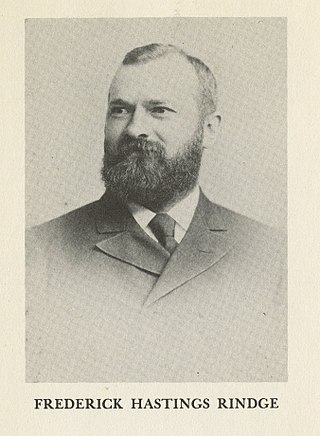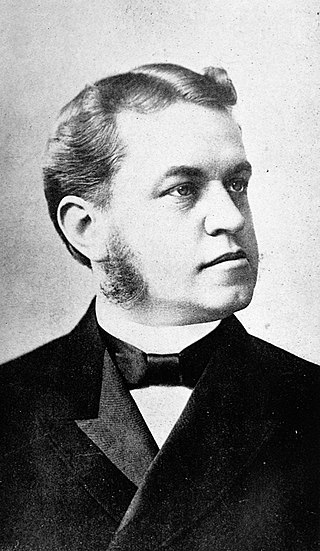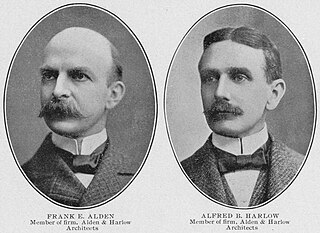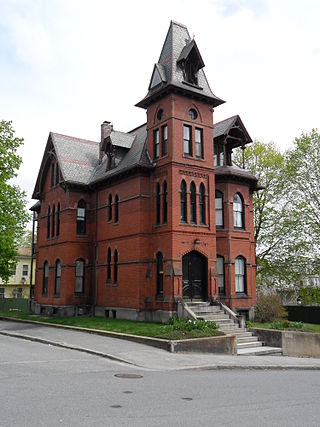
Frederick Hastings Rindge (1857–1905) was an American business magnate, patriarch of the Rindge family, real estate developer, philanthropist, and writer, of Los Angeles, California. He was a major benefactor to his home town of Cambridge, Massachusetts and a founder of present-day Malibu, California.
United Methodist Free Churches, sometimes called Free Methodists, was an English nonconformist community in the last half of the 19th century. It was formed in 1857 by the amalgamation of the Wesleyan Association and the Wesleyan Reformers.

John Lewis Bates was a lawyer and Republican politician from Massachusetts.

Joseph Flintoft Berry was a bishop of the Methodist Episcopal Church, elected in 1904.
The United Methodist Church in Great Britain was a Protestant denomination which operated from 1907 to 1932. It was a relatively small grouping of British Methodism, formed in 1907 by the union of the United Methodist Free Churches with two other small groupings, the Bible Christian Church and the Methodist New Connexion.
Founded in 1889, the Epworth League is a Methodist young adult association for people aged 18 to 35. It had its beginning in Cleveland, Ohio, at its Central Methodist Church on May 14 and 15, 1889. There was also a Colored Epworth League.

The Cambridge Common Historic District is a historic district encompassing one of the oldest parts of Cambridge, Massachusetts. It is centered on the Cambridge Common, which was a center of civic activity in Cambridge after its founding in 1631. It was the site of the election for governor of the Massachusetts Bay Colony in 1636, and was a military barracks site during the American Revolutionary War. The common was gradually reduced in size to its present roughly triangular shape, and surrounded by buildings in the 18th and 19th centuries. In 1973 a historic district encompassing the extant common and everything within 100 feet (30 m) of it was listed on the National Register of Historic Places. In 1987 the district was amended to rationalize the boundary, which overlapped adjacent districts and included portions of some buildings.

Brindley & Foster was a pipe organ builder based in Sheffield who flourished between 1854 and 1939.

Longfellow, Alden & Harlow, of Boston, Massachusetts, and Pittsburgh, Pennsylvania, was the architectural firm of Alexander Wadsworth Longfellow Jr. (1854–1934), Frank Ellis Alden (1859–1908), and Alfred Branch Harlow (1857–1927). The firm, successors to H. H. Richardson, continued to provide structures in the Romanesque revival style established by Richardson that is often referred to as Richardsonian Romanesque.

Henry Van Brunt FAIA was an American architect and architectural writer.
The Wesleyan Methodist Church was the majority Methodist movement in England following its split from the Church of England after the death of John Wesley and the appearance of parallel Methodist movements.
The Reverend Edwin William Smith FRAI was a Primitive Methodist missionary/anthropologist and author who was born in South Africa, studied at Elmfield College from 1888, and then worked in Africa. The scholar of African Christian history, Adrian Hastings refers to 1925–1950 as "the age of Edwin Smith".

Charles Francis Rice was a prominent minister and author. He was a member of the New England Conference of the Methodist Episcopal Church for 50 years, serving as a District Superintendent for five years and as President of the Massachusetts Federation of Churches for 10 years.

Amos Porter Cutting (1839–1896) was an American architect from Worcester, Massachusetts.

William Coolidge Lane was an American librarian and historian. He served for over 45 years in the Harvard Library at Harvard University in Cambridge, Massachusetts.

Harriet Merrick Warren was an American editor. She was also an untiring worker in the Woman's Foreign Missionary Society, its first recording secretary, and for years, president of the New England Branch. Warren is remembered as a "major leader of 'Woman's Work for Woman'" movement.
William Grant Seaman was a notable Methodist Episcopal minister, academic, and leader in "civic and social causes," including the City Methodist Church in Gary, Indiana.
Alice Sudduth Byerly was an American temperance philanthropist. For several years, she was National Superintendent of the Flower Mission Department of the Woman's Christian Temperance Union (WCTU).

Newhall & Blevins was an American architecture firm based in Boston, Massachusetts, active from 1903 to 1933. It was the partnership of architects Louis C. Newhall (1869–1925) and Albert H. Blevins (1874–1946). Newhall established a practice alone in 1901, forming his partnership with Blevins in 1903. They were partners until 1919, and remained associated until the death of Newhall in 1925. After Newhall's death, the firm was reorganized as Newhall & Blevins Inc. with John W. Reth (1888–1940) as president and treasurer. Reth was an engineer and construction supervisor who had been with Newhall & Blevins for several years. The firm was dissolved in 1933, apparently due to financial troubles.
Bertha Fowler was an American educator, as well as a Methodist Episcopal Church preacher and deaconess. In 1901, she established the Woman's Home Missionary Society of the Methodist Episcopal Church, which united with the Woman's Foreign Missionary Society of the Methodist Episcopal Church in 1908.












